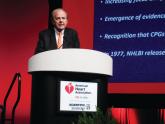Adoption of BP control to less than 130/80 mm Hg by groups such as the National Quality Forum (NQF), National Committee for Quality Assurance (NCQA), and America’s Health Insurance Plans (AHIP) “would add more pressure to comply, especially in an environment where there already is division of opinion between the ACC/AHA and American Association of Family Physicians,” agreed John P.A. Ioannidis, MD, professor of medicine and a preventive medicine specialist at Stanford (Calif.) University.“The AHA is looking for endorsement from the metric groups,” noted Brent M. Egan, MD, vice president for research at the Care Coordination Institute in Greenville, S.C., and a consultant to the AHA.
But a new performance metric that reflects the ACC/AHA BP target won’t appear immediately. Step one is crafting performance measures based on the ACC/AHA guideline to submit to the NQF and similar groups, a process that will soon start, said Donald E. Casey Jr., MD, a member of the guideline-writing panel and chief clinical affairs officer at Medecision in Wayne, Pa.. He will chair a committee that will review existing hypertension management performance measures and as needed also write new measures based on the guideline, a process he expects to have completed by the end of 2018. After that comes field testing the measures, and if they prove effective and workable, the next step is to submit them to the performance metric groups for review and potential adoption, steps that may take another year. In short, performance metrics for hypertension management that call for a large segment of U.S. patients to be treated to a BP below 130/80 mm Hg likely won’t be in place until the end of 2019 or sometime in 2020 at the earliest, and of course only if the metric-setting groups decide to adopt the new measures as part of their standards.
“It takes a while for guidelines to go from publication to practice. Once [the new guideline] is systematized into performance measures it will help” adoption of what the new guideline recommends, Dr. Casey said in an interview.
